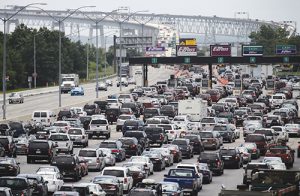
OCEAN CITY — Governor Larry Hogan this week announced the start of a study that will identify a potential location and explore possible funding options for a third Chesapeake Bay crossing to help alleviate growing congestion around the existing parallel spans.
Hogan on Tuesday announced the $5 million Tier 1 National Environmental Policy Act (NEPA) study, which was approved by the Maryland Transportation Authority (MDTA) board just last week. The study will begin this fall and could take as long as four years. It is considered an important next step in what will likely be a decades-long attempt to construct a third Chesapeake Bay crossing.
“Marylanders across the state depend on being able to cross the Chesapeake Bay, but the reality is there is simply too much traffic and that it will continue to get worse,” said Hogan this week. “This Tier 1 study is a critical first step needed in order to move forward on addressing the long-term issue of future traffic congestion on the Chesapeake Bay Bridge.”
NEPA requires state and federal agencies to consider the environmental consequences of proposed projects as part of their decision-making process. It provides the flexibility to assess projects in a staged approach. The Tier 1 study will pursue regulatory agency concurrence and agreement from the Eastern Shore counties on one crossing location.
The study will include traffic, engineering and environmental analyses, cost-per-mile estimates, preliminary financing and procurement options and an economic and land-use study. While the existing twin bridges have a lot of life left and any third span construction is likely decades away, the Tier 1 study announced this week sets in motion a long process.
“The Bay Bridge can be maintained safely through 2065 with preservation and maintenance work, however, studies show that by 2040, motorists could experience up to 14-mile delays,” said Maryland Transportation Secretary Pete Rahn this week. “This is the first step in a long process to address the demand for additional capacity across the Chesapeake Bay.”
State Senator Jim Mathias, who represents Worcester County and much of the Lower Shore, sponsored legislation during the 2016 General Assembly session calling for a study for a third span across the Chesapeake. The bill breezed through the Senate with a 41-3 vote, but stalled in the House as the session expired. Mathias this week praised Hogan for picking up the ball and running with it.
“I appreciate the governor’s announcement that there will be an environmental study into a third Bay Bridge span,” he said. “It certainly expedites the purpose and intent of my bill, Senate Bill 56, from the 2016 session and so I am very gratified that my efforts have been recognized.”
Mathias said the governor’s announcement about the third Bay Bridge study represented successful bipartisan collaboration.
“I’m also proud to say that this is yet another example of what we accomplish when we work together,” he said. “I truly appreciate my colleagues that worked with me on this matter. We thank Governor Hogan for his vision and leadership and now we can move forward.”
Mathias said traffic issues with the existing spans area already causing delays, expediting the need to consider a third crossing. He said the governor’s announcement this week sets in motion a process to accomplish that.
“It’s without question that a third bridge span will be required to accommodate future traffic congestion along Route 50,” he said. “Recent studies have projected severe and regular vehicular backups from Bay Bridge travelers up to 14 miles. This clearly sends a strong message to residents, visitors and business people on the Eastern Shore that we will have the necessary infrastructure to meet our future needs.”

